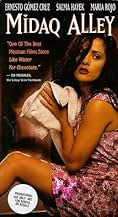IMDb RATING
7.3/10
3.5K
YOUR RATING
The lives of men and women living on Callejón de los Milagros in Mexico City.The lives of men and women living on Callejón de los Milagros in Mexico City.The lives of men and women living on Callejón de los Milagros in Mexico City.
- Awards
- 27 wins & 13 nominations total
- Director
- Writers
- All cast & crew
- Production, box office & more at IMDbPro
Featured reviews
My Cable company just recently added the new Spanish HBO to my system. And I just so happen to be flipping through these channels looking for something to watch (you know, it's really late and there is nothing else on), well I came to the Spanish HBO and a movie was just starting with sub-titles. I thought, hey why not. This movie "Midaq Alley" was excellent. It had everything in a movie you could asked for. I recommend this movie highly to everyone, no matter what your ethnic background is - you will walk away from this movie with something. Trust me.
The movie Midaq Alley follows different characters to show everyday life for a small community in Mexico while the viewer sees the same story from a different perspective. I think the same scene placed at the beginning of each synopsis that shows some older men playing dominoes in Don Ru's cantina is symbolic because it is representative of an ordinary day and also shows how people in the community gather together and share stories and get to know one another. I feel that it represents the culture in Mexico and emphasizes how everyone looks out for one another, like how Ubaldo looks out for Eusebia's sadness and how Dona Cata looks out for Susanita's feelings, and also how Abel looks out for Chava's well being. By making this scene the establishing shot for each time the viewer sees a different point of view begin, the director is trying to portray how significant gathering for a game of Dominos in the cantina is in the daily lives of those in Midaq Alley. There are also some street scenes where it seems everyone knows one another. I wonder if it is a custom to be so close to neighbors and care for them like family, or if it has to do with the small size of their community. I was not really surprised that the ending was not extremely dramatic. I think it was very fitting to leave things the way they were because the movie was a portrayal of everyday life. I feel that the scenes of the men playing Dominos at Don Ru's cantina are the most important scenes of the film because it tells the viewer that although the characters presented have complex lives, the actions they take to reach their individual happiness are mundane when you take a look at the bigger picture, especially when you realize the men playing dominoes are older and have gone through many life experiences, perhaps they are trying to tell us to relax and not take life so seriously.
This is a very interesting film. The three stories in the film are connected in some way, and yet not completely connected. The first story explores the issue of homosexuality, which I think is a brave idea in a country that is quite religious. The film is beautifully shot, and the locations seem realistic and reflect the daily life of the people.
Naguib Mahfouz, the Egyptian novelist, whose "Midaq Alley" serves as the basis of this film, wrote about the characters that populate that narrow strip of an Egyptian city, and how in some ways, all of their lives are so inter-connected to one another.
Director Jorge Fons and the adapter, Vicente Lenero, transferred the action to Mexico City. They used the same format that Alejandro Gonzalez Inarritu later used for his successful "Amores Perros" in 2000. It would be unfair to compare both films, yet, one can see certain parallels in the way the films unfold. Each narrative shows exact moments in which the lives of the people that part of town prove pivotal for the stories presented in the film.
There are four stories in the film. Each deals with what happened to that particular character while all have points in which they connect with the others. The film shows that when Mexican filmmakers want to tell interesting human stories, such as the ones depicted in the film, they don't have a thing to envy to the best types of cinema of the world. This is clearly a movie that will survive because of its universal themes.
Salma Hayek was making her second appearance in front of the cameras. She proved why she was an actress to be reckoned with. Her Alma shows a vulnerability, and freshness as she approaches the character. Ernesto Gomez Cruz, Maria Rojo, Bruno Bichir, Daniel Gimenez Cacho, Luis Felipe Tovar and the rest of the cast do excellent ensemble work under Mr. Fons direction.
The film will not disappoint the viewer.
Director Jorge Fons and the adapter, Vicente Lenero, transferred the action to Mexico City. They used the same format that Alejandro Gonzalez Inarritu later used for his successful "Amores Perros" in 2000. It would be unfair to compare both films, yet, one can see certain parallels in the way the films unfold. Each narrative shows exact moments in which the lives of the people that part of town prove pivotal for the stories presented in the film.
There are four stories in the film. Each deals with what happened to that particular character while all have points in which they connect with the others. The film shows that when Mexican filmmakers want to tell interesting human stories, such as the ones depicted in the film, they don't have a thing to envy to the best types of cinema of the world. This is clearly a movie that will survive because of its universal themes.
Salma Hayek was making her second appearance in front of the cameras. She proved why she was an actress to be reckoned with. Her Alma shows a vulnerability, and freshness as she approaches the character. Ernesto Gomez Cruz, Maria Rojo, Bruno Bichir, Daniel Gimenez Cacho, Luis Felipe Tovar and the rest of the cast do excellent ensemble work under Mr. Fons direction.
The film will not disappoint the viewer.
She quickly went on to fame in Desperado and From Dusk Til Dawn, but this, Salma Hayek's second film role, shows her acting talent.
In the first of four tales, she is just window dressing. An object of desire for a young boy (Bruno Bichir). While she is sitting, Don Ru (Ernesto Gómez Cruz) is yelling at his son (Juan Manuel Bernal) for acting like "a queer" while he himself pursues Jimmy (Esteban Soberanes); and Susanita (Margarita Sanz) is getting her fortune told by Almita's (Hayek) mother, Catalina (María Rojo).
After Don Ru's son runs away thinking he has done something awful, and he buries his head in his wife's lap moaning. the story starts all over with an emphasis on Almita. She, tragically, ends up with Jose Luis (Daniel Giménez Cacho) and disappears.
Susanita is growing older and desperate to find a man. She fancies Don Ru's son, but ends up with Guicho (Luis Felipe Tovar).
So, does the prodigal son return? Does Almicita come home? How are things to end? The story is first rate and it has you on the edge of you seat wondering how it all ties together.
In the first of four tales, she is just window dressing. An object of desire for a young boy (Bruno Bichir). While she is sitting, Don Ru (Ernesto Gómez Cruz) is yelling at his son (Juan Manuel Bernal) for acting like "a queer" while he himself pursues Jimmy (Esteban Soberanes); and Susanita (Margarita Sanz) is getting her fortune told by Almita's (Hayek) mother, Catalina (María Rojo).
After Don Ru's son runs away thinking he has done something awful, and he buries his head in his wife's lap moaning. the story starts all over with an emphasis on Almita. She, tragically, ends up with Jose Luis (Daniel Giménez Cacho) and disappears.
Susanita is growing older and desperate to find a man. She fancies Don Ru's son, but ends up with Guicho (Luis Felipe Tovar).
So, does the prodigal son return? Does Almicita come home? How are things to end? The story is first rate and it has you on the edge of you seat wondering how it all ties together.
Did you know
- TriviaVeronica Falcón's debut.
- ConnectionsFeatured in Cuba mon amour (1997)
- How long is Midaq Alley?Powered by Alexa
Details
- Runtime2 hours 20 minutes
- Color
- Sound mix
- Aspect ratio
- 1.85 : 1
Contribute to this page
Suggest an edit or add missing content























